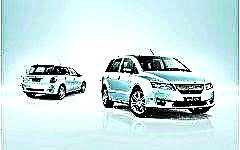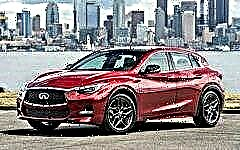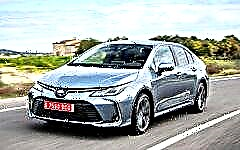

In the photo: Mercedes-Benz G63 AMG 6 × 6
The content of the article:
- The most "voracious" cars in Germany
For more than half a century, German cars have held the status of the highest quality, most reliable and technologically advanced cars in the world.
However, today we want to look at the car industry in Germany from a slightly different angle and talk about the most "gluttonous" German cars. But before we start, we want to note that the rating was compiled on the basis of official data on the average fuel consumption per 100 km of the distance traveled.
The most "voracious" cars in Germany
Mercedes-Benz 450 SEL 6.9 (W116)

In 1974, within the framework of the Geneva Motor Show, Mercedes-Benz presented the luxury sedan 450 SEL 6.9, which received the in-plant index W116. Car production started in 1975 and continued until 1981.
At that time, the car had a first-class appearance and high-quality interior, complemented by all sorts of "chips". However, the most important feature of the sedan was a powerful 6.9-liter gasoline engine, producing 286 hp. with. and maximum 550 Nm of torque.
With him, the car exchanged a hundred in less than 8 seconds. and could reach a top speed of 225 km / h. However, such a power plant had a slight drawback - the average fuel consumption was 17.4 liters per hundred.
Mercedes-AMG G65

In 2015, the Mercedes G-class with an internal factory index W463 underwent a planned restyling, during which it acquired a slightly retouched appearance, an improved interior and an expanded list of standard and optional equipment.
In addition, the SUV received upgraded engines, on top of which is a 6-liter AMG V12 biturbo petrol engine with a capacity of 630 hp. With him, the car exchanges a hundred in less than 5 seconds. and accelerates to 230 km / h, while the combined fuel consumption is an impressive 17.4 liters for every 100 kilometers.
Mercedes-Benz G63 AMG 6 × 6

In 2013, specialists from the court Mercedes studio AMG presented an exclusive version of the G63 6-wheel SUV to the world public. The main difference between the new items and the usual "Gelika" was the presence of three axles, providing the car with phenomenal cross-country ability. Truth, visually 6-wheeled "monster" looks, to put it mildly, awkward.
Under the hood of the car is an eight-cylinder 5.5-liter engine producing 554 hp. and peak 760 Nm of torque. The engine is combined with a 7-speed "automatic" and an innovative all-wheel drive system with 5 differentials.
Despite the impressive dimensions and considerable weight, the car accelerates from zero to hundreds in 6 seconds. and can reach the maximum 160 km / h, consuming an average of about 22 liters of gasoline per 100 km.
Mercedes-Benz CL 600

In 1996, the Mercedes management decided to bring the large coupes, previously related to the S-Class, into a separate line - this is how the CL-Class was born. One of the most curious models of the newly formed class was the CL600, which was based on the S600 solutions.
The car boasted a stylish exterior and a first-class interior, in which every element was thought out literally to the smallest detail.
In 1999, the company introduced the 2nd generation of the model, and 3 years later - its restyled version. This car was available with several powerplant options, at the top of the hierarchy of which was a 6-liter 612-horsepower gasoline engine, consuming an average of about 16.8 l / 100 km.
BMW 840 Ci (E31)

In the period 1993-1999, the model range of the Bavarian automaker BMW included a sports coupe 840 Ci, which has an internal factory index E31.
In the period 1993-1995, the car was aggregated with a 4-liter 286-horsepower gasoline engine, and after 1995 it was replaced by a new 4.4 liter engine, which has a similar power, but has a noticeably lower fuel consumption.
So, in the first case, the car consumed on average just over 20 l / 100 km, and after modernization - about 18 l / 100 km.
For its time, the model had an incredibly stylish and modern appearance that looks decent even by the standards of today.
Porsche Carrera GT

In 2000, in Geneva, Porsche presented a concept car of a new supercar, which did not start mass production until 2003.
The car can rightfully be considered one of the most stylish and attractive Porsche models in the history of the company.
The heart of the Carrera GT is the 5.7-liter petrol V10, traditionally installed at the rear of the car. Its output was 612 liters. and 590 Nm of torque, which were transmitted to the wheels through a 6-speed manual transmission.
This symbiosis provided acceleration from standstill to hundreds in 3.9 seconds, a maximum speed of 330 km / h and an average fuel consumption of 17.8 liters for every 100 km of track. When driving within the city, fuel consumption could well reach 29 l / 100 km.
BMW X5 M 2010

The first generation of the "charged" crossover BMW X5 M debuted on the world stage in 2009, while large-scale serial production was launched in 2010.
In comparison with the usual X5, the car received different front and rear bumpers, larger front air intakes and a neat diffuser with two pairs of exhaust pipes.
The interior design almost completely repeats that in the "civil" version of the crossover, with the exception of the stylish multifunction steering wheel, made in the corporate M-style, as well as the presence of special M-nameplates.
The "heart" of the car is a powerful 555-horsepower V8, which accelerates the car to a hundred in 4.7 seconds. and capable of reaching a peak of 250 km / h. According to official figures, the average fuel consumption in combined mode reaches 16 l / 100 km.
Mercedes-Benz G 55 Kompressor

Between 2006 and 2008, Mercedes launched a special version of its iconic G 55 Kompressor SUV, featuring a recognizable "cube" design, excellent off-road capabilities and a high-quality interior.
Under the hood of the SUV, a 5.5-liter gasoline V8 was installed, producing 500 liters. and maximum 700 Nm of thrust. This was enough for an almost 2.5-ton car to accelerate to a hundred in 5.6 seconds. and develop peak 210 km / h.
The fuel consumption in the combined mode was 16.3 l / 100 km, while in the city the car easily “devoured” over 21 liters of fuel.
Mercedes-Benz ML 63 AMG

In 2011, without waiting for the start of the annual Los Angeles Auto Show, Mercedes presented a "charged" version of the ML 63 AMG crossover, which received the W166 in-plant index.
The car received minor changes in appearance, represented by new bumpers, side "skirts" and 4 exhaust pipes.
The interior of the crossover has remained practically unchanged, retaining excellent ergonomics, first-class finishing materials and a wide list of pre-installed equipment.
The ML 63 AMG is powered by an uprated 5.5-liter bi-turbo engine that generates 525 hp. sec., which provides acceleration to 100 in 4.8 seconds, a maximum speed of 250 km / h and a combined "appetite" within 16.5 l / 100 km.
Mercedes-Benz G 500 4 × 4

In 2015 in Geneva, Mercedes unveiled a special version of the G 500 4 × 4 SUV, which is a simplified version of the 6-wheel G63 AMG. The exterior of the car is made in the style of the G63 AMG 6x6, while the car boasts 450 mm ground clearance, reinforced suspension and impressive R22 wheels.
Under the hood of the SUV, a 4-liter bi-turbo petrol engine was installed, paired with a 7-speed "automatic" and generating 422 liters. with.
According to official sources, the car accelerates from zero to hundreds in 6 seconds. develops about 210 km / h and consumes an average of about 17 l / 100 km, which is noticeably less than the 6-wheel G63 AMG.
Conclusion
As you can see, most of the cars presented in the selection belong to the Mercedes brand, which is not surprising, because its specialists have tried to squeeze the maximum out of their cars for many years, which is especially noticeable in the G-class lineup.











